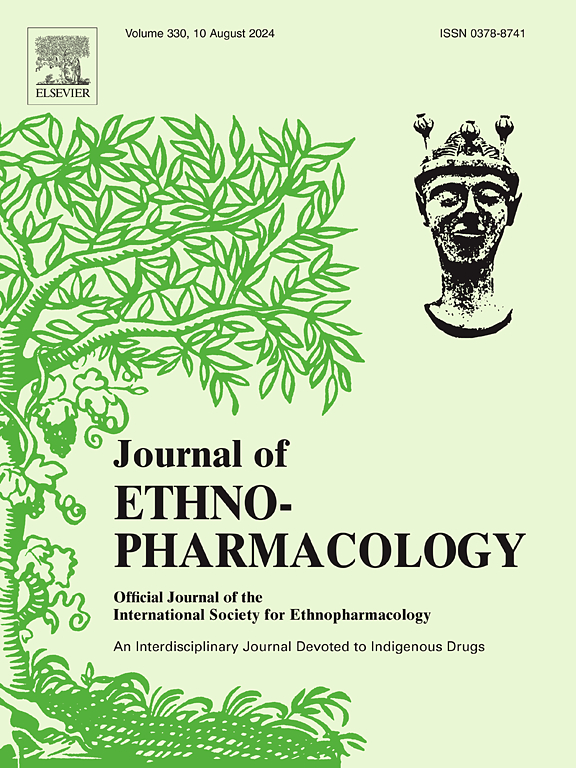摘要
民族药理学意义千阳育阴颗粒(Qian Yang Yu Yin Granule,QYYYG)是一种传统的中药复方制剂,经临床试验证实可减轻高血压患者的心脏重塑(CR)和心脏损伤。材料与方法以自发性高血压大鼠(SHRs)为高血压 CR 模型,采用 QYYYG 进行干预。测试血压、心脏功能和结构、组织病理学变化、心肌炎症和氧化应激,以评估 QYYYG 对 SHR 的疗效。在体外实验中,使用异丙肾上腺素构建了心肌肥厚和损伤的细胞模型。使用不同浓度的 QYYYG 处理后,对心肌细胞肥大、氧化应激和死亡进行了检测,并进行了转录组学分析以探索其潜在机制。结果发现了Nrf2和ROS/NF-κB/NLRP3炎性体通路。随后,使用 ML385 和 siRNA 抑制心肌细胞中的 Nrf2,以验证 QYYYG 是否通过靶向 Nrf2 负向调节 NLRP3 炎性体,从而改善相关表型。结果QYYYG改善了SHR的血压、心脏功能和结构重塑,减轻了心肌炎症、氧化应激和细胞死亡。转录组学研究结果表明,炎症反应可能是病理 CR 的关键因素,而 Nrf2 可能对这一过程起负性调节作用,QYYYG 治疗可上调 Nrf2。此外,QYYYG确实促进了Nrf2的激活,并负向调节了ROS/NF-κB/NLRP3炎性体通路,从而改善了相关表型。体外抑制或敲除 Nrf2 会削弱甚至逆转 QYYYG 对 ISO 诱导的炎症、氧化应激、热休克和 NLRP3 炎症体激活的抑制作用。根据高效液相色谱和分子对接的结果,包括咖啡黄素、染料木素、橙皮素和福莫尼定在内的 30 种化合物与 Keap1-Nrf2 蛋白有结合位点,可能会影响 Nrf2 的活性或稳定性。具体来说,QYYYG 通过促进 Nrf2 信号传导,抑制心肌炎症、氧化应激和热蛋白沉积,从而阻断 NLRP3 炎性体的激活,有效改善高血压 CR。Ethnopharmacological relevance
Qian Yang Yu Yin Granule (QYYYG), a traditional Chinese poly-herbal formulation, has been validated in clinical trials to mitigate cardiac remodeling (CR), and cardiac damage in patients with hypertension. However, the specific mechanism remains unclear.
Aim of the study
This study explored the potential effects and potential mechanisms of QYYYG on hypertensive CR by combining various experimental approaches.
Materials and methods
Spontaneously hypertensive rats (SHRs) were used as a model of hypertensive CR, followed by QYYYG interventions. Blood pressure, cardiac function and structure, histopathological changes, and myocardial inflammation and oxidative stress were tested to assess the efficacy of QYYYG in SHRs. For in vitro experiments, a cell model of myocardial hypertrophy and injury was constructed with isoprenaline. Cardiomyocyte hypertrophy, oxidative stress, and death were examined after treatment with different concentrations of QYYYG, and transcriptomics analyses were performed to explore the underlying mechanism. Nrf2 and the ROS/NF-κB/NLRP3 inflammasome pathway were detected. Thereafter, ML385 and siRNAs were used to inhibit Nrf2 in cardiomyocytes, so as to verify whether QYYYG negatively regulates the NLRP3 inflammasome by targeting Nrf2, thereby ameliorating the associated phenotypes. Finally, high performance liquid chromatography (HPLC) was conducted to analyze the active ingredients in QYYYG, and molecular docking was utilized to preliminarily screen the compounds with modulatory effects on Nrf2 activities.
Results
QYYYG improved blood pressure, cardiac function, and structural remodeling and attenuated myocardial inflammation, oxidative stress, and cell death in SHRs. The transcriptomics results showed that the inflammatory response might be crucial in pathological CR and that Nrf2, which potentially negatively regulates the process, was upregulated by QYYYG treatment. Furthermore, QYYYG indeed facilitated Nrf2 activation and negatively regulated the ROS/NF-κB/NLRP3 inflammasome pathway, therefore ameliorating the associated phenotypes. In vitro inhibition or knockdown of Nrf2 weakened or even reversed the repressive effect of QYYYG on ISO-induced inflammation, oxidative stress, pyroptosis, and the NLRP3 inflammasome activation. Based on the results of HPLC and molecular docking, 30 compounds, including cafestol, genistein, hesperetin, and formononetin, have binding sites to Keap1–Nrf2 protein and might affect the activity or stability of Nrf2.
Conclusion
In conclusion, the alleviatory effect of QYYYG on hypertensive CR is related to its regulation of Nrf2 activation. Specifically, QYYYG blocks the activation of the NLRP3 inflammasome by boosting Nrf2 signaling and depressing myocardial inflammation, oxidative stress, and pyroptosis, thereby effectively ameliorating hypertensive CR.

 求助内容:
求助内容: 应助结果提醒方式:
应助结果提醒方式:


